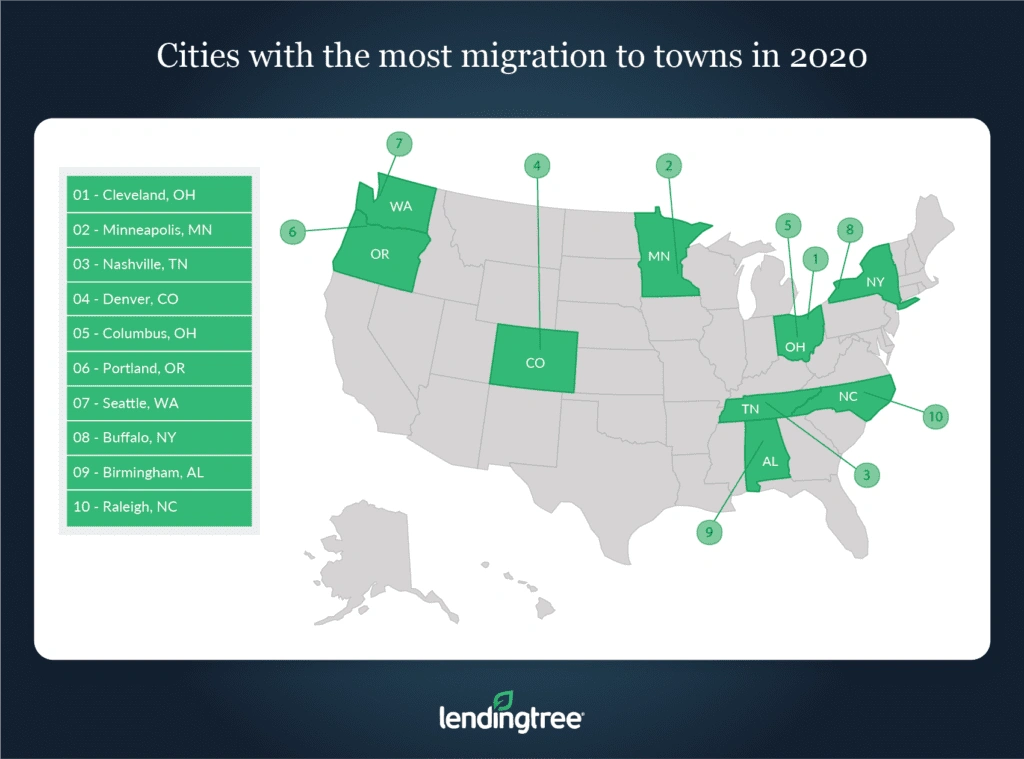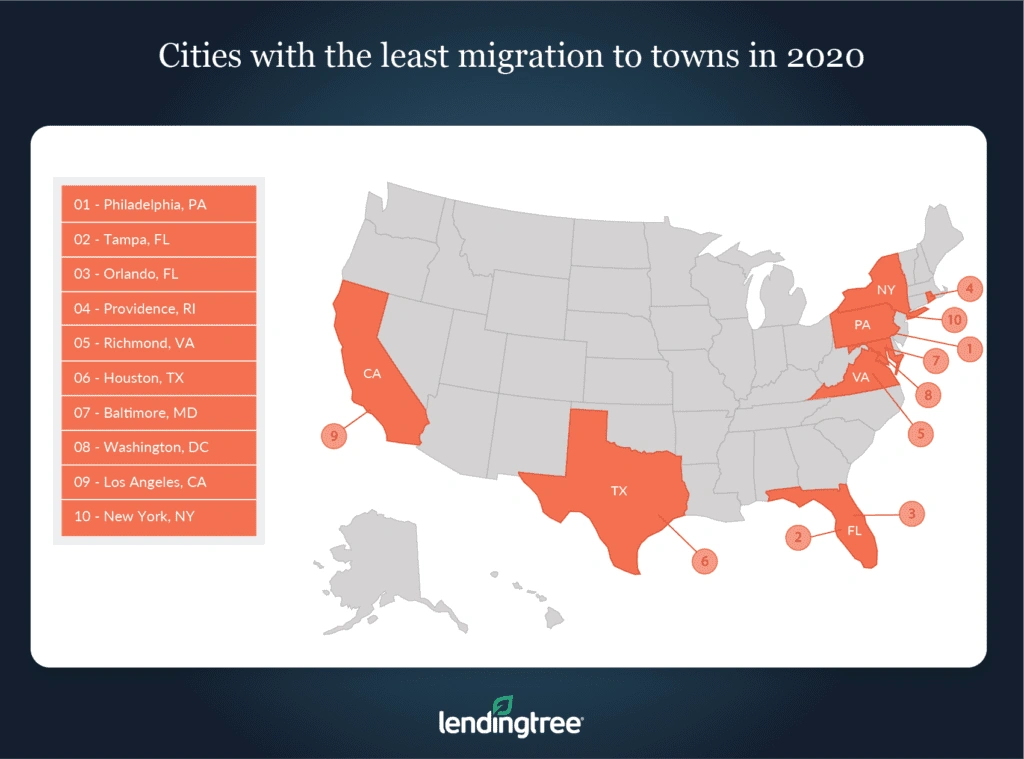LendingTree Finds That Homeowners Might Not Be Moving Away from Cities in Droves After All
The changing landscape caused by the COVID-19 pandemic, coupled with a new freedom to work from home, has led to some speculation that people will migrate en masse from cities to less expensive and less dense towns.
But are people really leaving big cities for smaller towns? A new study from LendingTree compared migration data from 2019 and 2020 to find out.
Specifically, LendingTree looked at the share of homeowners who lived in one of the nation’s 50 largest cities and moved to a new home in one of the country’s towns. By comparing the share of relocating homeowners who did this in 2019 to the share in 2020, LendingTree determined whether or not homeowners are actually leaving cities in significant numbers.
Ultimately, the study shows that while a slightly larger percentage of homeowners from big cities have moved to towns in 2020 than in 2019, the share of movers has remained largely the same in the past two years. This suggests that while some people may be looking to escape a big city by buying a home in a smaller town, most are staying put for the time being.
Key findings
- More homeowners are leaving a metropolitan area for a micropolitan area in 2020 than they did in 2019, but not by much. In 2019, an average of 1.91% of homeowners who lived in one of the nation’s 50 largest cities and moved, moved to a town. In 2020, that share was 2.18%.
- Homeowners moving from a city to a town tend to stay in the same state. Homeowners who moved from 37 of the nation’s 50 largest metropolitan areas stayed in the same state as the city they left.
- Few homeowners who move actually relocate out of the city that they’re currently living in. An average of 97.46% of homeowners who lived in one of the nation’s 50 largest cities and moved either moved to a different home within that same city or moved to a different city altogether. Of that number, an average of 84.06% stayed in the same city, while 15.94% left for another city.
- Cleveland, Minneapolis and Nashville, Tenn. are the cities with the most migration to towns. Respectively, 4.85%, 4.28% and 3.64% of movers from these cities moved to a town in 2020.
- Philadelphia, Tampa, Fla. and Orlando, Fla., saw the least migration to towns. Each of these cities saw less than 1% of movers head to a town.
Cities with the most migration to towns in 2020
No. 1: Cleveland
- Share of moving homeowners who migrated to a town in 2020: 4.85
- Share of moving homeowners who migrated to a town in 2019: 3.99%
- Most popular town for moving Cleveland homeowners to migrate to in 2020: Van Wert, Ohio
- Share of moving homeowners who relocated to the most popular town for Cleveland’s townbound homeowners in 2020: 18.21%
No. 2: Minneapolis
- Share of moving homeowners who migrated to a town in 2020: 4.28%
- Share of moving homeowners who migrated to a town in 2019: 4.40%
- Most popular town for moving Minneapolis homeowners to migrate to in 2020: Winona, Minn.
- Share of moving homeowners who relocated to the most popular town for Minneapolis’ townbound homeowners in 2020: 29.77%
No. 3: Nashville, Tenn.
- Share of moving homeowners who migrated to a town in 2020: 3.64%
- Share of moving homeowners who migrated to a town in 2019: 3.42%
- Most popular town for moving Nashville homeowners to migrate to in 2020: Tullahoma-Manchester, Tenn.
- Share of moving homeowners who relocated to the most popular town for Nashville’s townbound homeowners in 2020: 14.98%

Metros with the least migration to towns in 2020
No. 1: Philadelphia
- Share of moving homeowners who migrated to a town in 2020: 0.83%
- Share of moving homeowners who migrated to a town in 2019: 0.71%
- Most popular town for moving Philadelphia homeowners to migrate to in 2020: Pottsville, Pa.
- Share of moving homeowners who relocated to the most popular town for Philadelphia’s townbound homeowners in 2020: 11.17%
No. 2: Tampa, Fla.
- Share of moving homeowners who migrated to a town in 2020: 0.94%
- Share of moving homeowners who migrated to a town in 2019: 0.91%
- Most popular town for moving Tampa homeowners to migrate to in 2020: Key West, Fla.
- Share of moving homeowners who relocated to the most popular town for
- Tampa’s townbound homeowners in 2020: 5.00%
No. 3: Orlando, Fla.
- Share of moving homeowners who migrated to a town in 2020: 0.96%
- Share of moving homeowners who migrated to a town in 2019: 0.99%
- Most popular town for moving Orlando homeowners to migrate to in 2020: Richmond-Berea, Ky.
- Share of moving homeowners who relocated to the most popular town for
- Orlando’s townbound homeowners in 2020: 12.10%

Is now a better time than usual to move from a city to a town?
While the data indicates that most homeowners aren’t moving in the wake of the COVID-19 pandemic, nearly half of Americans report that they’re considering a move to help lower their housing costs. And, with similar numbers reporting that they’re able to work remotely, moving out of a city to a cheaper town might be a good idea.
However, the decision to move isn’t an easy one, and there are some potential drawbacks you should consider before moving to a town.
For example, even though many Americans are currently working from home, it’s not guaranteed that their remote working arrangements will be permanent. That means that if they leave the city they’re currently living in, they might find themselves out of a job if they can’t commute back to the office.
In addition, some towns can be just as expensive as big cities are. Plus, many rural areas of the country have seen significant spikes in COVID-19 cases, suggesting that some of the health and savings benefits associated with towns may be diminished. Yet another wrinkle: Low housing inventories might make finding a new home more difficult in some parts of the country.
Because of these downsides, it’s impossible to say whether or not moving from a city to a town is a better option than it has been in the past. Certainly, more flexibility in how and where employees can work, coupled with near record-low interest rates, might make buying a home outside of a city more feasible than in recent years. Nonetheless, would-be movers should carefully assess the pros and cons as they consider whether or not to pack their bags and relocate.
Methodology
Data for this study is derived from homeowners on the LendingTree platform who lived in one of the nation’s 50 largest metropolitan areas and bought a home in any one of the nation’s micropolitan areas at any time from Jan. 1, 2019 through Nov. 30, 2020.
For the purposes of this analysis, LendingTree used micropolitan-level data and metropolitan-level data as defined by the U.S. Census Bureau to approximate for town-level and city-level data, respectively.
LendingTree research analyst Jacob Channel contributed to this study.
View mortgage loan offers from up to 5 lenders in minutes
Read more
Florida Is Most Desired Destination for Out-of-State Home Shoppers Updated April 7, 2025 Florida was the top destination for nine states’ residents looking to buy elsewhere, while Texas…Read more
Selling and Buying a House at the Same Time: How It Works Updated February 6, 2025 Real estate markets are still extremely competitive. To move quickly, you might plan to buy…Read more

